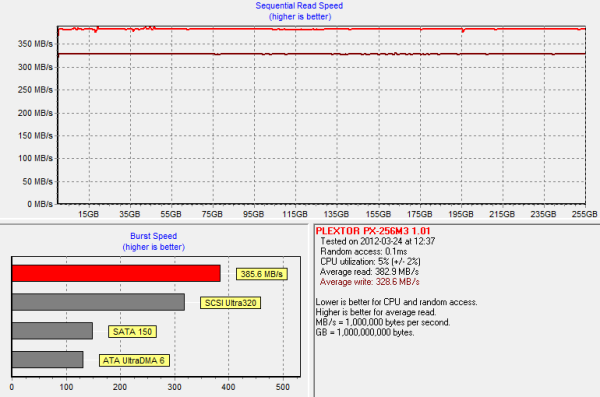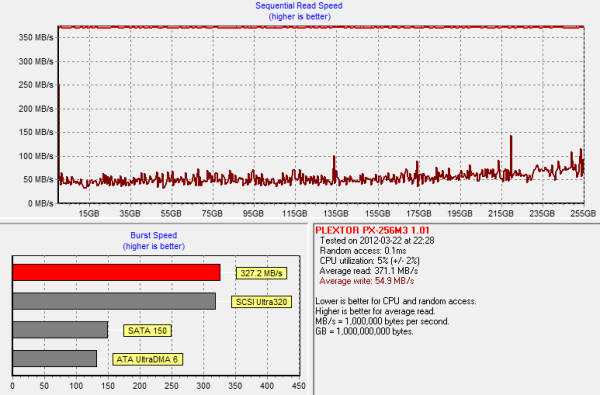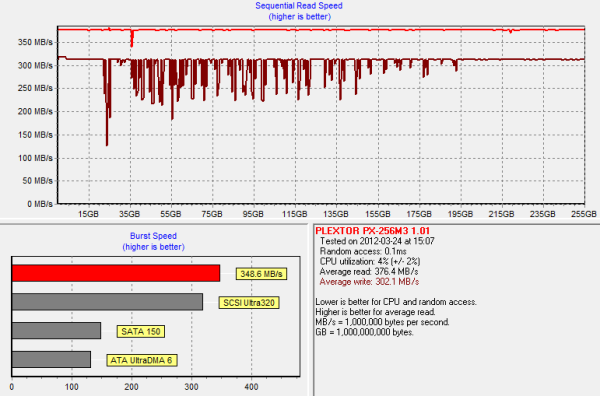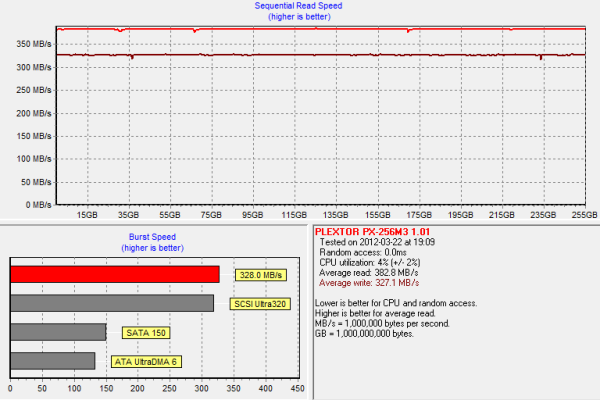The Plextor M3 (256GB) Review
by Kristian Vättö on April 5, 2012 3:05 AM ESTPerformance Over Time and TRIM
When Plextor sent the drive in for review, they emphazised one thing: a technology they call "True Speed". Supposedly, its job is to guarantee a high performance experience throughout the lifetime of the drive, and even when the drive is at a dirty state. As this technology is firmware related, we don't know how it differs from what others (e.g. Intel and Crucial) have done.
First, lets get the base performance by running HD Tach on a clean drive:
In a clean state, we get 383MB/s read speeds and 329MB/s write speeds. Next we ran the drive through our torture test, which consists of 20 minutes of 4KB random writes (QD=32, 100% LBA space) run on a full drive:
The M3 is still able to manage an average write speed of ~163MB/s. However, the write speed drops to as low as 50MB/s for the first LBAs, while the peak performance is still easily over 300MB/s. Plextor does noticeably better than Crucial in this regard as the performance of the m4 dropped to an average of 35MB/s. However, it should also be noted that the M3 had a higher write speed to begin with.
I wasn't ready to let Plextor go this easily. To see how the "True Speed" technology really works, I secure erased the drive, filled it with sequential data and then tripled the amount of 4KB random writes to 60 minutes:
The amplitude of the graph is a lot smaller now and there are only two small peaks, compared to the previous graph with dozens of peaks. The performance drop is significant as we are looking at 50MB/s on average regardless of the LBA. At the lowest, the performance is 35-40MB/s. That's still better than the Crucial m4, however, even with three times the random data thrown at the M4.
Next I secure erased the drive, reran our 20 minute torture test and let the drive idle for 40 minutes:
It does recover pretty well and we are looking at almost as new performance. There are a few negative peaks where the write speed drops to ~130MB/s, but on average the performance is only 25MB/s short of clean performance.
Finally I formatted the drive to see how it responds to the ATA TRIM command:
And the performance is back to brand new.
These graphs show us that if you are running an operating system with TRIM support (e.g. Windows 7), then there is absolutely no problem with the Plextor M3. If you are running an OS with no official TRIM support for the SSD (e.g. Mac OS X), then a SandForce based SSD will still be a better choice in this regard. However, what I would like to note is that our torture test reflects an extreme usage case.
Even if you are an enthusiast or professional, it's unlikely that your usage model will put the drive in a similar state as our torture test. Our torture test is continuously writing 4KB random data across the drive; in the real world there is almost always some sequential data and idle time in between. As shown in the garbage collection graph, the M3 does not need hours of idle time to restore its performance, so it should maintain its performance pretty well even under an OS with no TRIM.















113 Comments
View All Comments
Kutark - Thursday, April 5, 2012 - link
I thought it kind of odd that the author hadn't heard of plextor until a couple of months ago. IMO basically anybody who had been building their own comps since the mid 90's should at least have heard of the brand.I wonder how old the author is. This kind of reminds me of when you mention Everquest in a conversation and the WOW generation has no clue what you're talking about.
BTW im not meaning to imply or say anything negative about the author, it just struck me as an odd thing to say.
Kutark - Thursday, April 5, 2012 - link
Well, had i read the comments i would seen that the author is 18, which explains quite a lot (again, not in a bad way)jabber - Thursday, April 5, 2012 - link
I thought the Plextor of old went bust years ago and the name was bought up by someone else?Basically standard goods with the Plextor name silkscreened on for 50% extra mark up.
I just threw out my trusty Plextor 712SA drive after about 8 years hard use.
Topweasel - Thursday, April 5, 2012 - link
No, as DVD burners became throwaway items (Sub $50) they started to offer re-branded parts, but higher quality ones. You could still tell from little things like the tray mechanism that they weren't Plextor. They also ran into a stumbling block with optics for DVD burners for the few they still manufactured. Since they are compared to the big ones, more of a boutique designer they had trouble at 16x+ of eeking out that last bit of quality. Which meant for their more expensive drives, they weren't king of the hill, meaning if reliability and not burning performance or burn quality were your concerns, then you wouldn't pay the extra amount. For the rebrands, they were actually price competitive even if they were like $5-$10 bucks more.Then came Blu-Ray drives. That did almost kill them. No one was/is buying them. Not like they would DVD drives. Internal drives also never hit the extremes that for example a DVD drive did at launch where they were $300-$400. So once again they were manufacturing expensive drives that no one was buying, and they couldn't even rebrand to make it more price competitive. That's why they went to SSD's, unlike OCZ that made the move because SSD's where much higher margin parts. Plextor did it to survive. But again they don't even have to make to many of these. Plextor makes its living as a low volume high quality high performance manufacturer. Even at their worse in 2008-2010, they were only just as good as everyone else. SSD's are just a product that they can produce that performance actually matters and higher prices are acceptable.
But no Plextor today is the same Plextor of old. Just with a new focus, but same goal.
Beenthere - Thursday, April 5, 2012 - link
Plextor has the potential to sell some decent SSDs. I think the M3 Pro should be the base model with the 3M pricing and Plextor should work on a true Pro model. The Pro pricing is unacceptable and the M3 performance lacking IMO.GrizzledYoungMan - Thursday, April 5, 2012 - link
Any reason to use 10.2 over 10.6?Kristian Vättö - Thursday, April 5, 2012 - link
From a user's standpoint, no. For reviews it's important to use the same set of software and drivers as an updated version may impact performance. In other words, we would have to test all SSDs again if we updated Intel RST to 10.6. That's why we are sticking with 10.2, at least for now.Maiyr - Thursday, April 5, 2012 - link
"Plextor as a brand is probably a new acquaintance for most people and I have to admit that I had not heard of Plextor until a couple of months ago."I must be getting old. That just seems crazy to me.
Maiyr
jwilliams4200 - Thursday, April 5, 2012 - link
With regards to idle power, the 256GB Crucial m4 shows half the idle power of the 256GB Vertex 4 in your chart, but they both have the same amount of synchronous flash.And since they are both using a Marvell controller (the V4 has a rebadged Marvell 88SS9187, the m4 has an 88SS9174), it is clear that the biggest factor in idle power consumption is NOT the amount and type of flash memory.
Kristian Vättö - Friday, April 6, 2012 - link
You really need some proof that the Indilinx Everest 2 is just a rebadged Marvell 88SS9187, I've seen nothing that indicates so.Of course the controller draws power as well and it can lead to high power consumption, so NAND is definitely not the only factor - I was only pointing out that Toggle NAND is more power efficient. It's possible that a future firmware update will decrease the power consumption of Vertex 4, that happened with Vertex 3 at least.